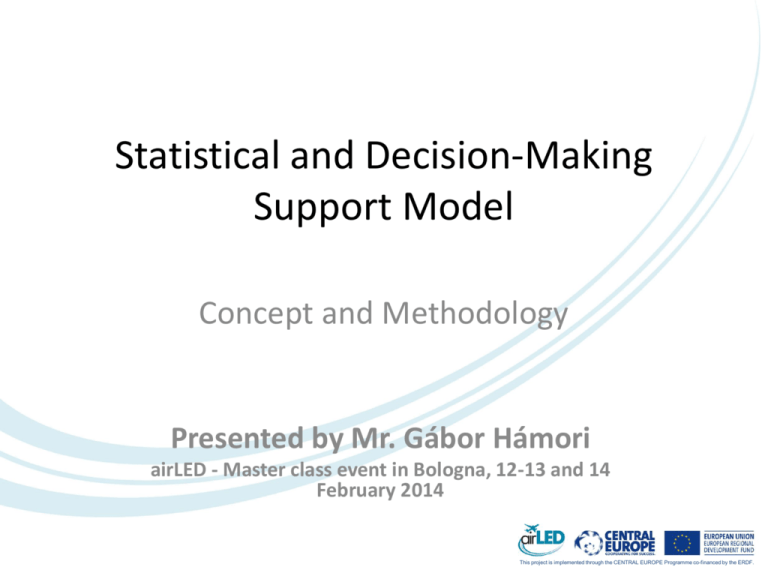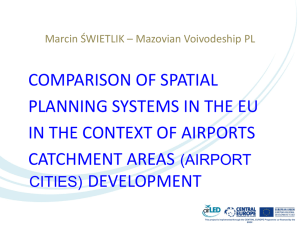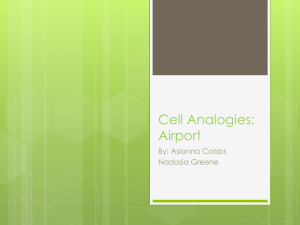Master class event in Bologna, 12-13 and 14 February 2014
advertisement

Statistical and Decision-Making Support Model Concept and Methodology Presented by Mr. Gábor Hámori airLED - Master class event in Bologna, 12-13 and 14 February 2014 This project is implemented through the CENTRAL EUROPE Programme co-financed by the ERDF. • The statistical decision support model as a part of airLED project, conducted by the responsible Partner, namely the municipality of Budapest district 18. • The conception of the statistical model was approved by the responsible Partner. Current status: construction of the database. This project is implemented through the CENTRAL EUROPE Programme co-financed by the ERDF. Milestones of the conception I. Defining airport catchment area II. Selecting initial set of Latent variables: determining the relevant statistical dimensions of the economic development, compilation of data III. Database testing IV. Refinement of the model estimate: recalculation and iteration, finalization of indicators V. Analysis of economic indicators of airport companies VI. Time series analysis of the final socio-economic indicators VII. Define the predictive model VIII. Modeling tool for transnational use This project is implemented through the CENTRAL EUROPE Programme co-financed by the ERDF. Milestone I • I. Statistical definition of the Impact zones. Direct and indirect impact zones are in the scope of the model according to the Status Quo analysis. In the area of BUD Airport the direct impact zone consist of 6 Budapest districts 7 towns, and further 17 Budapest districts and 39 towns are related to the indirect impact zone. All together these 69 districts and towns are the observation units (statistical population) of the cross sectional database (2011 now). In the database all units are marked by the impact zone status (direct or indirect). This project is implemented through the CENTRAL EUROPE Programme co-financed by the ERDF. Milestone II • II. Collecting the socio-economic dimensions (latent factors) and the related manifest variables of the impact zone of the BUD-Airport. Issue of data collection: Completness: Those data are appropriate which are available for all units, and all of the relevant data need to be collected. Non-Redundancy : Avoid the redundancy among the information Try to collect time series data for all towns included in the analysis. This project is implemented through the CENTRAL EUROPE Programme co-financed by the ERDF. Initial latent socio-economic variables 1. Demographic characteristics, geographical conditions 2. Employment, unemployment 3. Population income producing ability 4. Transportation infrastructure 5. Commercial infrastructure 6. Tourism, catering 7. Revenue generating capacity of municipalities 8. Economic activity of business 9. Income generating capacity of enterprises This project is implemented through the CENTRAL EUROPE Programme co-financed by the ERDF. Initial manifest socio-economic variables 1. • • • • • • • 2. • • • • Demographic characteristics, geographical conditions Resident population Population density (per km2) Migration to settlement per thousand inhabitants Migration from settlement per thousand inhabitants Children per hundred people in active age Elderly per hundred active age Territory of the settlement (hectare) Employment, unemployment Employees Registered jobseekers Persons with low educational attainment The number of registered unemployed per 100 working-age population This project is implemented through the CENTRAL EUROPE Programme co-financed by the ERDF. Initial manifest socio-economic variables 3. Population income producing ability • All domestic income (HUF) • All domestic income per one person resident population • All income per one person resident population deviation from the national average • 1 per taxpayer domestic income • Personal income tax per one inhabitant • Personal income tax per one taxpayer 4. Transportation infrastructure • Public roads within the settlement area • Length of public urban roads • Municipal roads and public space within the settlement area • Length of municipal roads and public space • Optimized path length of time • Settlement terrestrial connectivity indicators • Settlement aerial connectivity indicators • Settlement of ground connection capacity This project is implemented through the CENTRAL EUROPE Programme co-financed by the ERDF. Initial manifest socio-economic variables 5. Commercial infrastructure • The number of retail shops • The number of wholesale warehouses 6. Tourism, catering • Capacity of public accommodation establishments, specific indicators • Tourists and tourism nights in public accomodation , specific indicators 7. • • • • • • Revenue generating capacity of municipalities Local business tax, specific indicators Property(building) tax, specific indicators Land tax, specific indicators Communal tax (entrepreneurs and individuals), specific indicators Tourism tax, specific indicators Ceded central taxes (vehicle tax), specific indicators This project is implemented through the CENTRAL EUROPE Programme co-financed by the ERDF. Initial manifest socio-economic variables 8. Economic activity of business • Number of registered corporations by industries • The number of taxpayers per tax category • Economic structure – number of corporations, employees, income by industries 9. Income generating capacity of enterprises • Gross value added • Total value added per 1 person resident population deviation from the GDP per capita • Profit after tax • Incomes of individual entrepreneurs • Taxes paid This project is implemented through the CENTRAL EUROPE Programme co-financed by the ERDF. Milestones III-VI • III. Testing the database, exploration of the direction and the intensity of causual relationship between the indicators with Structural Equation Modeling (SEM) metodology, filtering out the non relevant variables, further data collection in the case of necessity, testreport . • IV. Definition of the model, recalculation (refinement), documentation of the final structure of the indicators. • V. Time series analysis of statistical and ecomomic indicators of the airport. • VI. Time series analysis of the final socio-economic indicators derived from town(district)-database. • The final socio-economic indicators of the airport data and the town (district) database may relate for the same time period. This project is implemented through the CENTRAL EUROPE Programme co-financed by the ERDF. Milestone VII • VII. The predictive model – Analysis of the time series of statistical and economic indicators of the airport and socioeconomic indicator set of the towns (districts) in a joint modell – Forecasting of predictors – Estimation of the target variables of a certain town (local taxes, employment) by the forecasted predictors. This project is implemented through the CENTRAL EUROPE Programme co-financed by the ERDF. Transnational application of the model • The definition of the relevant socio-economic indicators of the impact zones and the related modeling activity based on different available hungarian database. • Collection of analogous indicators recommended for the participant countries in the project. These indicators may have local characteristics. • Following tables show the variables (indicators) proposed by the Status Quo evaluation. This project is implemented through the CENTRAL EUROPE Programme co-financed by the ERDF. Index group Population Business activity Tourism Revenues Housing Airport Variables Data on catchment areas Aspect Period Population Net migration in and out of the area Number of people in employment Number of registered unemployed people by sex Number of permanent residents Residents by age cohorts and sex Number of active companies by NACE sectors Proportion of active companies in Budapest in various sectors Number of people in employment by NACE sector HUN,PC,BP PC,BP HUN,PC,BP HUN,PC,BP HUN,PC,BP HUN,PC,BP HUN,PC,BP BP HUN,PC,BP 2004-2011 2004-2011 2008-2012 2004-2011 2004-2011 2004-2011 2004-2011 2008-2010 2004-2012 Profile of the business and office parks in the close catchment area of the airport Total net take-up in the surveyed areas Total FDI flows in Hungary broken down by economic activities, net Share of services within total FDI flows into Hungary Number of international conferences Number of delegates and nationalities at international conferences Hungary’s and Budapest’s rank in the international ranking of conference locations Foreign visitors to Hungary by country Number of foreign visitors to Hungary by country of origin Number of foreign guests in collective tourist accommodation establishments Capacity of collective tourist accomodation establishments Nights spent by foreign guests in collective tourist accomodation establishments Number of rooms in four- and five-star hotels Utilization of rooms in hotels EU funds to Hungary in the latest budget periods: funds which can be applied for EU funds to Central Hungary in the 2007-2013 budget period, by priority themes, (HUF): funds which have been istributed Administrative income at the local level Number of new dwelling and new housing space in square metres Construction permits shifted forward by 3 quarters and occupancy permits Share of existing legally declared for ms of environmental protection in the direct and in direct impact zone of the airport BP BP HUN HUN HUN,BP HUN HUN,BP HUN HUN HUN,PC,BP HUN,PC,BP HUN,PC,BP HUN,PC,BP HUN,BP HUN NA 2008-2012 2008-2011 2008-2011 2004-2012 2004-2012 2011 2012 2004-2012 2004-2011 2004-2011 2004-2011 2008-2012 2004-2011 2007-2020 C-HUN HUN,PC,BP HUN,PC,BP HUN Catchment area 2007-2013 2004-2011 2004-2011 1995-2013 NA This project is implemented through the CENTRAL EUROPE Programme co-financed by the ERDF. Index group A i r p o r t Variables Aspect Data on BUD Airport and environment Share of respective groups of land in the area of restricted use BUD Airport Number of people inhabiting the area of restricted use BUD Airport Carried out and planned investments inside the borders of the airport and in its impact area BUD Airport Share of lands with diverse uses – actual situation BUD Airport Share of land with diverse uses – final state according to the airport master plan BUD Airport Change of share of areas with diverse functions BUD Airport Period NA NA NA NA NA NA Passenger traffic at Hungarian airports HUN,BUD Airport 2010 Cargo traffic at Hungarian airports Passenger traffic at Hungarian airports HUN,BUD Airport HUN,BUD Airport 2010 2004-2010 Cargo traffic at Hungarian airports Passenger and cargo traffic at Budapest Airports HUN,BUD Airport BUD Airport 2004-2010 2004-2010 Monthly passenger traffic in Budapest Airports BUD Airport 2010-2011 Monthly cargo traffic in Budapest Airport BUD Airport Authorities with headquarters (HungaroControl) or offices (Airport Police Department, Tax and Custom Office and the Transport Safety Authority) at the airport site BUD Airport 2010-2011 Companies at the Budapest Airport by profile BUD Airport Air connectivity Volume and trend of the yearly air cargo to and from the airport in the past 10 years Existing services at the airport 2011 BUD Airport BUD Airport 2011 NA BUD Airport BUD Airport 2002-2012 NA This project is implemented through the CENTRAL EUROPE Programme co-financed by the ERDF. Preliminary data collection concept for the partner region • The set of indicators will be finalized on Hungarian databases. In this step the partner regions do not have to provide any kind of data. • The finalized set of indicators related to the impact zone will be sent to the partner regions. These indicators should be sent for the available time periods then. The indicators are not country-specific, so they likely to be available in each partner region. • The forecasting model requires turnover time series data of the project related partner-airports for the available time period. This project is implemented through the CENTRAL EUROPE Programme co-financed by the ERDF.







